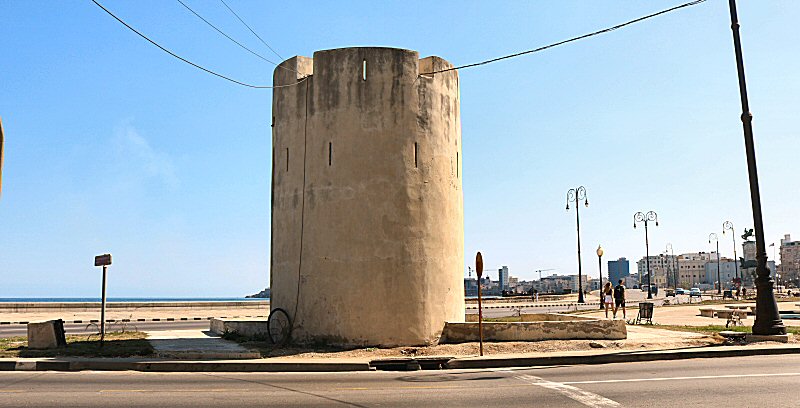

In 1650s the
main defense system of Havana against the potential naval
threats, consisted of three fortresses (the Casillo de la Real Fuerza, the Castillo de la Punta and the
Castillo de los Tres Reyes del Morro) and two torreóns (Torreón
de la Chorrera and the Torreón de Cojímar). Even so, the western
coast outside of the Havana Bay (the coastal region of the
current municapility Plaza de la Revolución) was out of the
range of the surveillance from the closest fortification due to
the topographic characteristics of the terrain.
Considering
this a gap in the surveillance sytem, a torreón (large tower for
the defense of a fortification or a square) was built at the
coast of the Caleta de Juan Guillén (current cove of San Lázaro)
that would serve as a link in the chain of fortifications around
Havana that were built to protect the city particularly from the Dutch and
British warships, as well as from the pirates that were roaming
the Caribbean Sea. Specifically, the function of the Torreón de
la Caleta was to look out to the horizon (for the candles of
navigating ships) and, in the presence of any enemy ship, to
warn the nearest fortifications like the Castillo de la
Punta and the Torreón de la Chorrera by torches. It would also supervise
and protect the transport of the wood from the region of the Almendares river to the Royal Arsenal and would prevent the possible
passage of aggressors to the forest in Vedado (Bosque del Vedado
del Rey) and Zanja Real (Royal Ditch, the first water channel of
Havana).
The Spanish
king entrusted the Dutch engineer Marcos Lucio to make changes
in the fortification system of Havana, including the
construction of a new fortification in the cove, in 1664. The
Dutch engineer completed the tower in 1665.
In 1781,
when the Real Hospital de San Lázaro, partially dedicated to leper
patients, was built very close to the
tower, the Torreón de la Caleta started to be called as Torreón
de San Lázaro.
Today, this
monument, even it is so small, represents the Municipality of
Centro Habana, as a symbol of rebellion and dignity of heroic
people.
The tower is
a cylinder of masonry with a diameter of about 4,5 meters. Its
walls have a thickness of about 1,3 meters and a height of about
9 meters. It has three levels. On the intermediate level, it has
loopholes for rifle shot, oriented in a network, and on the
upper level, a parapet with small embrasures. It has a wooden
entry door on the ground level.

